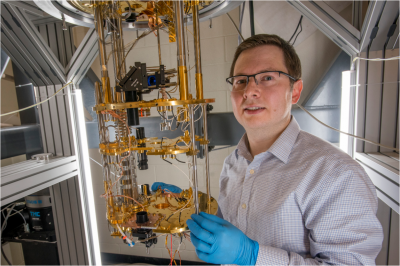Stretching Makes the Superconductor
Chemists and metallurgists have experimented with different combinations of elements for years, trying to get superconductors that work at temperatures close to room temperature (most superconductors only work when they’re super cold.) The idea is to come up with the perfect combination of elements that will have exactly the right density of electrons, at the right energies. When that happens, electrons pair up and move through the material in a synchronized way, even at temperatures above 77 degrees Kelvin, which is the temperature of liquid nitrogen. That’s considered a high-temperature superconductor, because liquid nitrogen is cheap to produce and can be used as a refrigerant. But finding the right chemistry to make new and better high-temperature superconductors has been elusive.
Sochnikov and his students are thinking about it differently. What if mechanical changes such as squeezing or stretching could make a material a superconductor? Changing the chemistry is ultimately about changing the arrangement of atoms and electrons in a material. Mechanical stresses can do the same thing, in a different way.
Tunneling Spectroscopy of c-axis Epitaxial Cuprate Junctions
Narrated powerpoint of Douglas Natelson's planned 2020 APS March Meeting presentation.
Tunnel junctions are valuable tools for electronic spectroscopy, with epitaxial structures minimizing extrinsic effects of disorder. We report tunneling spectroscopy measurements, over a broad temperature and bias range, in c-axis La2−xSrxCuO4/La2CuO4/La2−xSrxCuO4 heterostructures grown via atomic layer-by-layer molecular beam epitaxy. Above Tc of the LSCO layers, these structures show the pseudogap, while below Tc, the devices show superconductor/insulator/superconductor (SIS) response. Down to 20 mK there is no Josephson critical supercurrent Ic, indicating strongly incoherent transport. Tunneling spectra show greatly suppressed coherence peaks. The T=0 zero-bias conductance remains at approximately 20-30% that of the normal-state, implying a substantial population of unpaired carriers. As temperature is raised, the superconducting gap fills in rather than closing at Tc. The spectra show an inelastic tunneling feature at ∼0.08 eV, suppressed as T exceeds Tc. We discuss how these properties are inconsistent with standard d-wave tunneling expectations, despite the structural perfection of the epitaxial stack.

Breaking Up is Hard to Do (for Electrons in High Temperature Superconductors)
Physicists used to think that superconductivity – electricity flowing without resistance or loss – was an all or nothing phenomenon. But new evidence suggests that, at least in copper oxide superconductors, it’s not so clear cut...
Measuring the Charge of Electrons in a High-Temp Superconductor
Scientists found a large concentration of electron pairs outside key temperature and energy ranges; this finding could inform the search for new materials that conduct electricity without resistance at unusually high temperatures
A hallmark of superconductivity, beyond superconductivity itself
Physicists have found “electron pairing,” a hallmark feature of superconductivity, at temperatures and energies well above the critical threshold where superconductivity happens.
Scientists Create Nano-Patterned Superconducting Thin Films
A team of scientists from Bar-Ilan University and the U.S. Department of Energy’s (DOE) Brookhaven National Laboratory has fabricated thin films patterned with large arrays of nanowires and loops that are superconducting — able to carry electric current with no resistance — when cooled below about 30 kelvin (-243 degrees Celsius). Even more interesting, the scientists showed they could change the material’s electrical resistance in an unexpected way by placing the material in an external magnetic field.